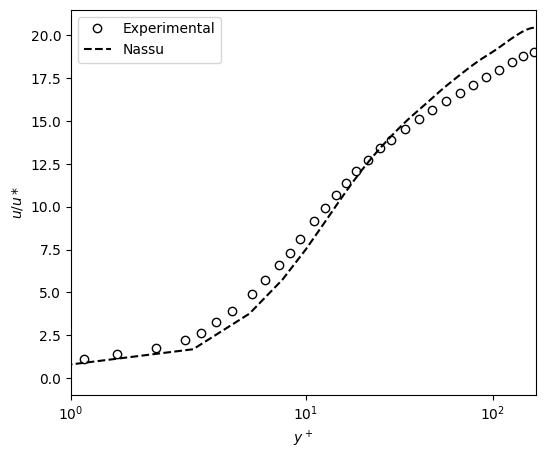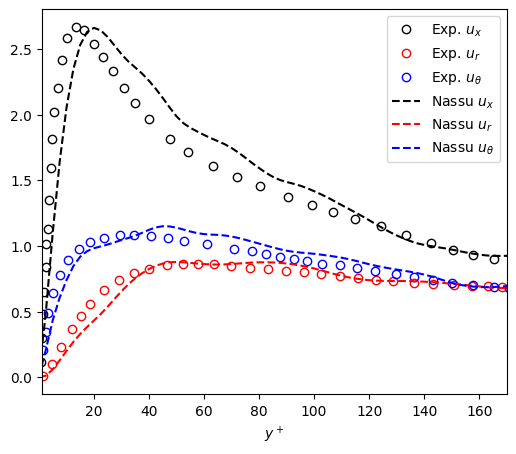Turbulent Pipe Flow (Reynolds 180)#
The simulation of a periodic turbulent pipe flow is used for the validation of the immersed boundary method effectiveness to delineate a curved boundary in a turbulent flow. As for the turbulent channel case, the external force density term represents the pressure gradient \(F_{x}=-\mathrm{d}p/\mathrm{d}x\), the regularized no-slip BC is employed at \(y=0\) and \(y=H\), and periodicity is considered in the remaining boundaries.
Note: A precursor turbulent flow is used to start the simulation and assure a turbulent flow. This field can be generated through a precursor poiseuille flow simulation with an Lagrangian body placed to generate perturbations and removed after turbulence is generated.
from nassu.cfg.model import ConfigScheme
filename = "tests/validation/cases/05_turbulent_pipe_flow.nassu.yaml"
sim_cfgs = ConfigScheme.sim_cfgs_from_file_dct(filename)
An extra spacing of 2 lattices at each side of the cylinder is kept to assure a complete interpolation-spread procedure.
sim_cfg = next(iter(sim_cfgs.values()))
Functions used for processing of turbulent pipe
from nassu.cfg.schemes.simul import SimulationConfigs
import numpy as np
from vtk.util.numpy_support import vtk_to_numpy
from tests.validation.notebooks import common
stats_export = sim_cfg.output.stats["default"]
last_step = stats_export.interval.get_all_process_steps(sim_cfg.n_steps)[-1]
reader = stats_export.read_vtm_export(last_step)
reader_output = reader.GetOutput()
def get_macr_compressed(
sim_cfg: SimulationConfigs, macr_name: str, is_2nd_order: bool
) -> tuple[np.ndarray, np.ndarray]:
global reader, reader_output
macr_name_read = macr_name if not is_2nd_order else f"{macr_name}_2nd"
ds = sim_cfg.domain.domain_size
p0 = np.array((ds.x // 2, 0, ds.z // 2))
p1 = np.array((ds.x // 2, ds.y - 1, ds.z // 2))
n_points = ds.y
pos = np.linspace(p0, p1, num=n_points, endpoint=True)
norm_pos = (pos[:, 1] + 0.5) / (len(pos) + 1)
# Sum 0.5 because data is cell centered in vtm
line = common.create_line(p0 + 0.5, p1 + 0.5, n_points - 1)
probe_filter = common.probe_over_line(line, reader_output)
probed_data = vtk_to_numpy(probe_filter.GetOutput().GetPointData().GetArray(macr_name_read))
return norm_pos, probed_data
Results#
Load values for comparison
import pandas as pd
import numpy as np
import os
comparison_folder = "tests/validation/comparison/Turbulent_pipe/Re_tau=180"
files = ["ux_avg", "uang_rms", "ur_rms", "ux_rms"]
get_filename_csv = lambda f: os.path.join(comparison_folder, f + ".csv")
df_cp = {f: pd.read_csv(get_filename_csv(f), delimiter=",") for f in files}
Friction velocity and y+ to use
yp = 2.5
u_fric = 0.003401361 * 0.925
Load simulation velocity fields
pos, ux_avg = get_macr_compressed(sim_cfg, "ux", is_2nd_order=False)
pos, ux_2nd = get_macr_compressed(sim_cfg, "ux", is_2nd_order=True)
ux_rms = (ux_2nd - ux_avg**2) ** 0.5
pos, uy_avg = get_macr_compressed(sim_cfg, "uy", is_2nd_order=False)
pos, uy_2nd = get_macr_compressed(sim_cfg, "uy", is_2nd_order=True)
uy_rms = (uy_2nd - uy_avg**2) ** 0.5
pos, uz_avg = get_macr_compressed(sim_cfg, "uz", is_2nd_order=False)
pos, uz_2nd = get_macr_compressed(sim_cfg, "uz", is_2nd_order=True)
uz_rms = (uz_2nd - uz_avg**2) ** 0.5
ux_avg.shape, ux_rms.shape
((152,), (152,))
wall_pos = 5 # From 4 to 148
mid_pos = ux_avg.shape[0] // 2
ux_vals = ux_avg[wall_pos:mid_pos] / u_fric
x_vals = np.arange(len(ux_vals)) * yp
import matplotlib.pyplot as plt
fig, ax = plt.subplots()
fig.set_size_inches(6, 5)
ax.plot(df_cp["ux_avg"]["y+"], df_cp["ux_avg"]["u/u*"], "ko", fillstyle="none")
ax.plot(x_vals, ux_vals, "k--")
ax.legend(["Experimental", "Nassu"])
ax.set_xscale("symlog")
ax.set_xlim((1, 170))
ax.set_ylabel("$u/u*$")
ax.set_xlabel("$y^+$")
plt.show(fig)

The average flow velocity shown below presents an excellent agreement with experimental results. Below, the root mean squared velocity \(u_{\alpha,\mathrm{rms}}\) is also presented against experimental data.
import matplotlib.pyplot as plt
fig, ax = plt.subplots()
fig.set_size_inches(6, 5)
get_prof_plot = lambda arr: arr[wall_pos:mid_pos] / u_fric
ax.plot(df_cp["ux_rms"]["y+"], df_cp["ux_rms"]["u/u*"], "ko", fillstyle="none")
ax.plot(df_cp["ur_rms"]["y+"], df_cp["ur_rms"]["u/u*"], "ro", fillstyle="none")
ax.plot(df_cp["uang_rms"]["y+"], df_cp["uang_rms"]["u/u*"], "bo", fillstyle="none")
ax.plot(x_vals, get_prof_plot(ux_rms), "k--")
ax.plot(x_vals, get_prof_plot(uy_rms), "r--")
ax.plot(x_vals, get_prof_plot(uz_rms), "b--")
ax.legend(
[
r"Exp. $u_x$",
r"Exp. $u_r$",
r"Exp. $u_{\theta}$",
r"Nassu $u_x$",
r"Nassu $u_r$",
r"Nassu $u_{\theta}$",
]
)
ax.set_xlim((1, 170))
ax.set_xlabel("$y^+$")
plt.show(fig)

Also, an excellement agreeement is obtained for all directions in cylindrical coordinates. In general the results confirm the solver capability of solving a pipe flow turbulence, confirming the IBM as adequate to represent a curved boundary and the D3Q27 velocity set as capable of axissymetric turbulence.
Version#
sim_info = sim_cfg.output.read_info()
nassu_commit = sim_info["commit"]
nassu_version = sim_info["version"]
print("Version:", nassu_version)
print("Commit hash:", nassu_commit)
Version: 1.6.33
Commit hash: fbc0edb5260d2734f0a290e1806c26ac6d865ff4
Configuration#
from IPython.display import Code
Code(filename=filename)
simulations:
- name: periodicTurbulentPipe
save_path: ./tests/validation/results/05_turbulent_pipe_flow/periodic
n_steps: 400000
# u* = 0.0034013 / R = 72 / ETT = R/u* = 18,820
# Re_tau = 180
# y+ = 2.5
report:
frequency: 1000
domain:
domain_size:
x: 456
y: 152
z: 152
block_size: 8
bodies:
cylinder:
lnas_path: fixture/lnas/basic/cylinder.lnas
transformation:
scale: [72, 72, 72]
translation: [-4, 4, 4]
data:
divergence: { frequency: 50 }
instantaneous:
default: { interval: { frequency: 200000 }, macrs: [rho, u] }
statistics:
interval: { frequency: 100, start_step: 200000 }
macrs_1st_order: [rho, u]
macrs_2nd_order: [u]
exports:
default: { interval: { frequency: 50000 } }
models:
precision:
default: single
LBM:
tau: 0.504081632653061
F:
x: 3.21368E-07
y: 0
z: 0
vel_set: D3Q27
coll_oper: RRBGK
initialization:
vtm_filename: "../nassuArtifacts/macrs/turbulent_pipe.vtm"
engine:
name: CUDA
BC:
periodic_dims: [true, false, false]
BC_map:
- pos: N
BC: RegularizedHWBB
wall_normal: N
order: 1
- pos: S
BC: RegularizedHWBB
wall_normal: S
order: 1
- pos: F
BC: RegularizedHWBB
wall_normal: F
order: 2
- pos: B
BC: RegularizedHWBB
wall_normal: B
order: 2
IBM:
forces_accomodate_time: 1000
body_cfgs:
default: {}
